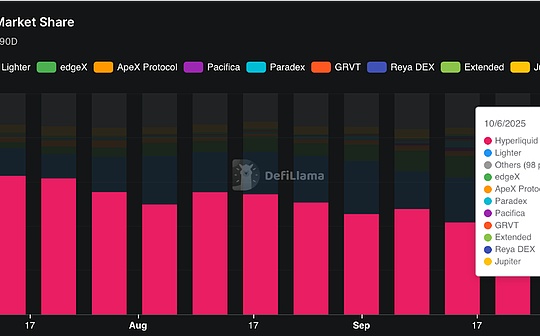
author:Wintermute; Translation: Bitchain Vision xiaozou
Last Friday, the United States announced that it would impose 100% tariffs on all imported goods from China starting from November 1, triggering a wave of risk aversion in major markets.The S&P 500 index fell 2.9%, the fear index VIX surged from 16 to 22, and the ten-year yield fell from 4.14% to 4.05%.Gold prices rose as investors de-risked and shifted to defensive allocations.Digital currencies also suffered heavy losses. The total amount of open positions before the incident reached 220 billion U.S. dollars, and 19 billion U.S. dollars of leveraged positions were liquidated in just a few hours, setting a record for the largest single-day liquidation in history.
Below are our observations on the spot perpetual contract and options markets.
1. Spot market
Based on centralized exchange data aggregation, we seeThe sell-off was swift and synchronized, most centralized exchange trading pairs bottomed out within 55 minutes (20:40 to 21:35 UTC time),Severe price fluctuations quickly lead to the depletion of overall market liquidity..Liquidity quickly returns as prices recover from the lows.
Based on the aggregate exchange data of the top 50 currencies we observe:
1. The median retracement range is -54%, and more than 90% of tokens have fallen by more than 10%..BTC (-11%) and ETH (-13%) have shown the strongest resilience, while small and medium-sized market capitalization assets have fallen by 60-80% at their peak.
2. Nearly all tokens in the global liquidation wave bottomed out around 21:20 UTC time, and then rebounded sharply as the forced selling closed, with the average rebound reaching +84% within 30 minutes.
3. Loss is negatively correlated with market capitalization: Based on the GMCI30 index, large-cap currencies fell by an average of -27%, and small-cap currencies fell by an average of -52%.Within an hour, the order book situation returned to normal, funds re-flowed to BTC, ETH and major first-tier network tokens, and the rebound of small market capitalization currencies lagged behind.
4. The overall trading depth of centralized exchanges dropped by about 65% during the trough period, but as the quotation frequency and spreads returned to normal, they returned to more than 90% of the pre-event level within 35 minutes.Although liquidity was provided during this period, the price difference between the quoted price and the central price expanded significantly.
2. Options market
After the impact of U.S. tariff policy triggered market panic on Friday, BTC futures positions quickly turned to a defensive stance, with traders scrambling for downside protection, pushingTotal options trading volume hits record high.
The data covers 24-hour activity during periods of tariff headlines and market sell-offs, with panic hedging dominating capital flows and short-term put options being actively bid.Market sentiment changed on Saturday,As BTC stabilizes near $115,000, trading strategies shift to volatility harvesting and range trading, profiting from selling call options and shorting calendar spreads.
Volatility surges on safe-haven demand,Implied volatility jumped 20-25 points from the 7th to the 14th, and put options with strike prices of US$105,000-115,000 had a premium of 10-15 volatility points relative to call options, setting one of the largest single-day option front-end increases on record..
Options trading volume hit a new high, mainly concentrated in the October expiration contract, with about 70% of premiums flowing into put options below $115,000., highlighting the strong demand for downside protection.The 24-hour trading volume on the Deribit platform doubled from the previous record.
On Saturday, capital flow reversed into volatility selling, with traders selling call options and straddle combinations in the range of $118,000-$130,000, pushing the 1-week implied volatility to compress from 63% to 51%, showing that the market quickly judged the tariff shock as a short-term disturbance.
3. Perpetual contract market
Amid Friday’s market plunge, both centralized and decentralized perpetual contract markets were tested to their limits., hundreds of millions of dollars in leveraged positions were liquidated within minutes.Centralized exchanges experienced record liquidation volumes and short-term liquidity gaps, and on-chain DEX perpetual contracts faced heavy pressure from the clearing system and treasury. However, mainstream DEX platforms maintained normal operations and solvency throughout the process.This incident became a real-life stress test for the resilience of the on-chain trading and margin systems.
Because some users adopted the long-short spread strategy, their short positions encountered automatic reduction ADL, causing the positions to temporarily deviate from the neutral state, and then the long positions faced liquidation as the price continued to fall.A total of more than 1,000 wallets on the Hyperliquid platform were automatically deleveraged, which may be one of the causes of this series of liquidations..
Take HYPE, which suffered the most severe liquidation on the entire network, as an example, with a liquidation amount of US$10.3 billion:
This liquidation triggered the first cross-margin automatic reduction ADL event on a mainstream DEX perpetual contract platform., the function of this mechanism is to resolve risks by closing part of the position of the profitable party when the reserve fund pool is exhausted.
Gas usage soared to a historical peak of 105K, approximately three times the daily average since March., and exceeded the previous high record by twice, reflecting the surge in on-chain clearing and trading activities during the event.
Let’s look at the situation of centralized exchanges:
Open interest takes a hit, most contracts shrank by about half during the plunge, showing a comprehensive leverage impact.
Funding rates turn sharply negative, which is a mechanical move driven by liquidations rather than position adjustments.There was only a partial recovery over the weekend, with funding rates still below average for most of the top 100 coins.
All this reminds us:In the cryptocurrency market, risk management and leverage control are crucial, and you must be prepared for emergencies.





